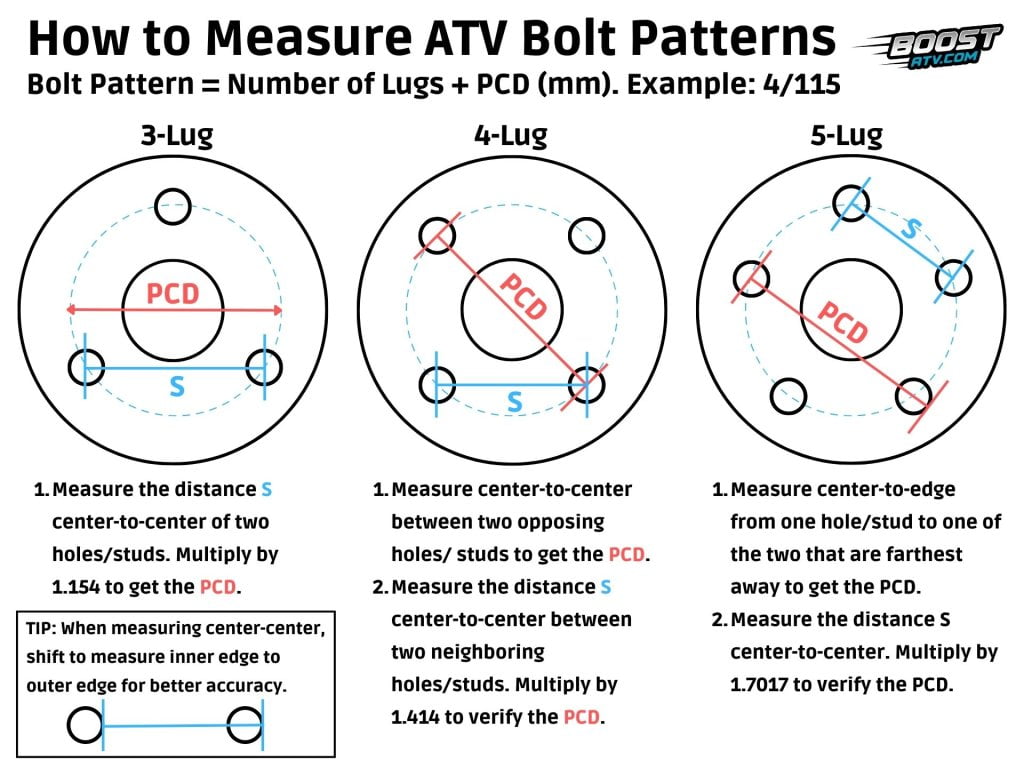Decoding the 5-Lug Bolt Pattern: Your Guide to Wheel Fitment

Ever stared at a wheel, mesmerized by the seemingly random arrangement of lug nuts? That's no accident. It's a precisely engineered 5-lug bolt pattern, a critical element of wheel fitment, and a key to unlocking the potential of your vehicle's performance and aesthetics. This guide decodes the secrets of the 5-lug, exploring its history, significance, and practical implications.
The 5-lug bolt pattern, also known as a 5-lug bolt circle, defines the arrangement of the five lug holes on a wheel hub. This pattern is crucial because it dictates which wheels will fit your vehicle. A mismatch can lead to vibrations, handling issues, and even catastrophic wheel failure. Understanding this seemingly simple arrangement is paramount for any car enthusiast or driver.
While four- and six-lug patterns exist, the five-lug configuration has become incredibly popular, especially in passenger cars and smaller SUVs. This prevalence likely stems from a balance between cost-effectiveness, strength, and weight. Five lugs provide adequate support for most vehicles in these categories without adding excessive weight or complexity.
The precise 5-lug configuration isn't universal. It's defined by two measurements: the number of lugs (five, in this case) and the diameter of the circle on which the lugs are placed, typically measured in millimeters or inches. This is known as the pitch circle diameter (PCD). For instance, a common 5-lug pattern is 5x114.3, indicating five lugs on a 114.3mm diameter circle. Knowing your vehicle's specific 5-lug bolt pattern is essential for proper wheel selection.
The origins of the five-lug bolt pattern are somewhat obscure, gradually evolving as automotive technology advanced. Early vehicles often employed fewer lugs, but as cars became faster and heavier, the need for greater load-bearing capacity led to the adoption of more robust designs. The five-lug configuration emerged as a sweet spot, offering a good balance of strength and weight efficiency.
One common issue related to 5-lug bolt patterns is incorrect identification. Using the wrong PCD can lead to dangerous situations. Another problem is cross-threading lug nuts due to improper installation, potentially damaging the wheel studs and making wheel removal difficult.
Three benefits of using the correct 5-lug bolt pattern are: Safety: Proper fitment prevents wheel detachment. Performance: Correctly fitted wheels ensure optimal handling and braking. Aesthetics: Matching the right wheels enhances your vehicle's appearance. For example, choosing a wheel with a 5x100 PCD for a car that requires 5x114.3 can result in wheel wobble and potential detachment.
Advantages and Disadvantages of 5-Lug Bolt Patterns
| Advantages | Disadvantages |
|---|---|
| Good balance of strength and weight | Less robust than 6-lug or higher patterns |
| Widely available wheel options | Potential for confusion with similar patterns |
| Cost-effective manufacturing |
Best Practices for Implementing 5-Lug Bolt Patterns:
1. Accurate Measurement: Always verify your vehicle's PCD using a reliable measuring tool.
2. Consult Manufacturer Specifications: Refer to your vehicle's owner's manual for the correct bolt pattern.
3. Use the Correct Lug Nuts: Ensure the lug nuts match the wheel and hub's seat type (conical or ball).
4. Proper Tightening Technique: Tighten lug nuts in a star pattern to ensure even distribution of pressure.
5. Regular Inspection: Check lug nuts for tightness after installation and periodically thereafter.
Real-World Examples: Honda Civic, Toyota Corolla, Mazda3, Ford Focus, and Hyundai Elantra commonly use 5-lug bolt patterns.
FAQs:
1. What is a 5-lug bolt pattern? It's the arrangement of five lug holes on a wheel hub.
2. How do I measure my 5-lug bolt pattern? Use a dedicated measuring tool or consult your vehicle's manual.
3. Why is it important to use the correct pattern? To ensure safety, proper handling, and prevent damage.
4. Can I use a different bolt pattern? No, using an incorrect pattern is dangerous.
5. What are common 5-lug patterns? 5x100, 5x114.3, and 5x112 are examples.
6. What happens if I use the wrong lug nuts? You can damage the wheel studs or cause the wheel to loosen.
7. Where can I find my car's bolt pattern? Your owner's manual or a reputable online resource.
8. What are the signs of an incorrect bolt pattern? Vibrations, wobbling, and unusual noises.
In conclusion, the 5-lug bolt pattern is a critical, often overlooked, aspect of vehicle safety and performance. Understanding its importance, identifying your vehicle's specific pattern, and adhering to best practices for wheel installation are essential for a smooth and safe driving experience. From preventing catastrophic wheel failure to ensuring optimal handling, the seemingly simple 5-lug pattern plays a significant role. Don't underestimate its impact; take the time to learn about your vehicle's 5-lug bolt pattern and ensure your wheels are correctly fitted. Your safety and driving experience depend on it. Take the time to research your vehicle's specific 5-lug bolt pattern requirements, consult reliable resources, and invest in quality components. The knowledge you gain will empower you to make informed decisions about wheel selection and maintenance, contributing to a safer and more enjoyable driving experience for years to come.
Transform your furniture with amazon chalk paint
Unlocking the secrets of the gm 6 lug bolt pattern
Benjamin moore paint in sandy utah your guide to perfect colors













